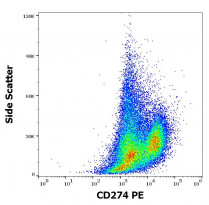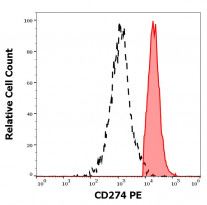ARG42338
anti-CD274 / PD-L1 antibody [29E.2A3] (PE)
anti-CD274 / PD-L1 antibody [29E.2A3] (PE) for Flow cytometry and Human,Primates
Overview
| Product Description | PE-conjugated Mouse Monoclonal antibody [29E.2A3] recognizes CD274 / PD-L1 |
|---|---|
| Tested Reactivity | Hu, NHuPrm |
| Tested Application | FACS |
| Specificity | The mouse monoclonal antibody 29E.2A3 recognizes an extracellular epitope of CD274 / PD-L1 (also known as B7-H1), a 40 kDa type I transmembrane protein expressed by dendritic cells, activated T cells, activated monocytes, and in various tissues, above all in heart and skeletal muscle, placenta and lung, and in many cancer cells, including T cell lymphomas, melanomas, and glioblastomas. |
| Host | Mouse |
| Clonality | Monoclonal |
| Clone | 29E.2A3 |
| Isotype | IgG2b, kappa |
| Target Name | CD274 / PD-L1 |
| Antigen Species | Human |
| Immunogen | Full length Human CD274. |
| Conjugation | PE |
| Alternate Names | Programmed cell death 1 ligand 1; B7-H1; B7H1; PDL1; PDCD1 ligand 1; B7 homolog 1; PD-L1; CD antigen CD274; PDCD1L1; B7-H; Programmed death ligand 1; PDCD1LG1 |
Application Instructions
| Application Suggestion |
|
||||
|---|---|---|---|---|---|
| Application Note | * The dilutions indicate recommended starting dilutions and the optimal dilutions or concentrations should be determined by the scientist. |
Properties
| Form | Liquid |
|---|---|
| Purification | Purified |
| Buffer | PBS and 15 mM Sodium azide. |
| Preservative | 15 mM Sodium azide |
| Storage Instruction | Aliquot and store in the dark at 2-8°C. Keep protected from prolonged exposure to light. Avoid repeated freeze/thaw cycles. Suggest spin the vial prior to opening. The antibody solution should be gently mixed before use. |
| Note | For laboratory research only, not for drug, diagnostic or other use. |
Bioinformation
| Database Links | |
|---|---|
| Gene Symbol | CD274 |
| Gene Full Name | CD274 molecule |
| Background | This gene encodes an immune inhibitory receptor ligand that is expressed by hematopoietic and non-hematopoietic cells, such as T cells and B cells and various types of tumor cells. The encoded protein is a type I transmembrane protein that has immunoglobulin V-like and C-like domains. Interaction of this ligand with its receptor inhibits T-cell activation and cytokine production. During infection or inflammation of normal tissue, this interaction is important for preventing autoimmunity by maintaining homeostasis of the immune response. In tumor microenvironments, this interaction provides an immune escape for tumor cells through cytotoxic T-cell inactivation. Expression of this gene in tumor cells is considered to be prognostic in many types of human malignancies, including colon cancer and renal cell carcinoma. Alternative splicing results in multiple transcript variants. [provided by RefSeq, Sep 2015] |
| Function | Plays a critical role in induction and maintenance of immune tolerance to self (PubMed:11015443, PubMed:28813417, PubMed:28813410). As a ligand for the inhibitory receptor PDCD1/PD-1, modulates the activation threshold of T-cells and limits T-cell effector response (PubMed:11015443, PubMed:28813417, PubMed:28813410). Through a yet unknown activating receptor, may costimulate T-cell subsets that predominantly produce interleukin-10 (IL10) (PubMed:10581077). The PDCD1-mediated inhibitory pathway is exploited by tumors to attenuate anti-tumor immunity and escape destruction by the immune system, thereby facilitating tumor survival (PubMed:28813417, PubMed:28813410). The interaction with PDCD1/PD-1 inhibits cytotoxic T lymphocytes (CTLs) effector function (By similarity). The blockage of the PDCD1-mediated pathway results in the reversal of the exhausted T-cell phenotype and the normalization of the anti-tumor response, providing a rationale for cancer immunotherapy (By similarity). [UniProt] |
| Cellular Localization | Cell membrane; Single-pass type I membrane protein. Early endosome membrane; Single-pass type I membrane protein. Recycling endosome membrane; Single-pass type I membrane protein. Note=Associates with CMTM6 at recycling endosomes, where it is protected from being targeted for lysosomal degradation. Isoform 1: Cell membrane; Single-pass type I membrane protein. Isoform 2: Endomembrane system; Single-pass type I membrane protein. [UniProt] |
| Highlight | Related products: PD-L1 antibodies; PD-L1 ELISA Kits; Anti-Mouse IgG secondary antibodies; Related news: Examining CTL/NK-mediated cytotoxicity by ELISA |
| Calculated MW | 33 kDa |
Images (2) Click the Picture to Zoom In
-
ARG42338 anti-CD274 / PD-L1 antibody [29E.2A3] (PE) FACS image
Flow Cytometry: Human PHA stimulated peripheral blood mononuclear cell suspension stained with ARG42338 anti-CD274 / PD-L1 antibody [29E.2A3] (PE) at 10 µl / 10^6 cells in 100 µl of cell suspension.
-
ARG42338 anti-CD274 / PD-L1 antibody [29E.2A3] (PE) FACS image
Flow Cytometry: Separation of Human CD274 positive cells (red-filled) from cellular debris (black-dashed). Human PHA stimulated peripheral blood mononuclear cell suspension stained with ARG42338 anti-CD274 / PD-L1 antibody [29E.2A3] (PE) at 10 µl / 10^6 cells in 100 µl of cell suspension.







